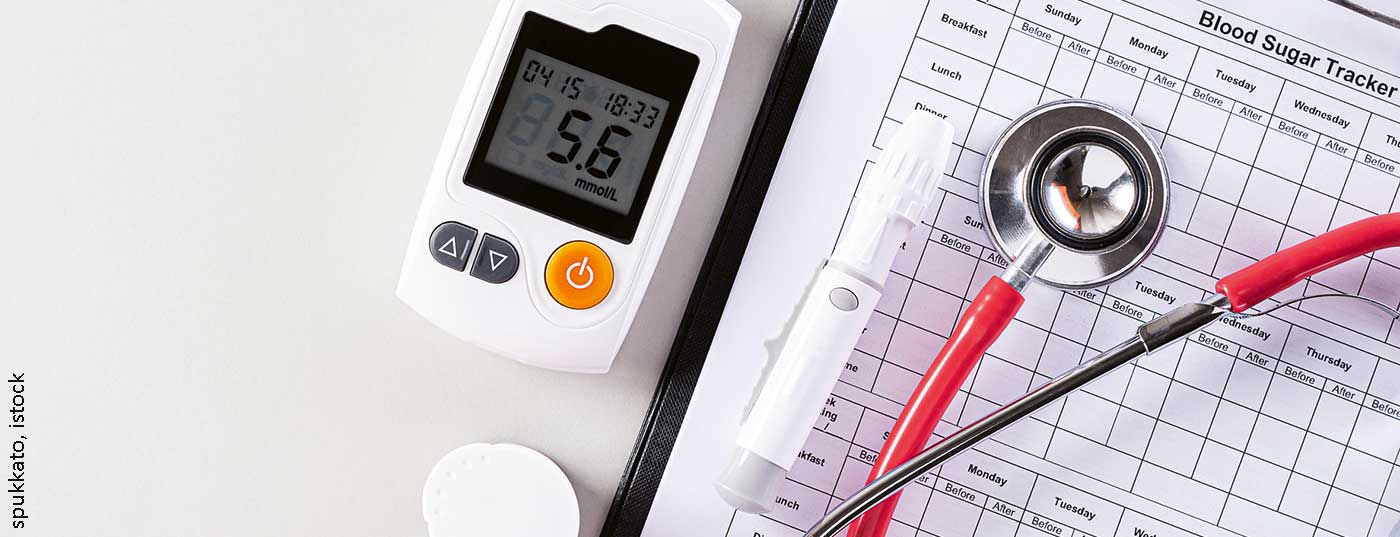Cardiac problems such as coronary artery disease and heart failure are among the most common and dangerous complications of type 1 diabetes. The mortality risk is significantly increased. Although this relationship is well known, a large proportion of those affected are inadequately adjusted with regard to the glycemic target value, hypertension and dyslipidemia. Effective risk management is needed here.
Life expectancy of patients with type 1 diabetes (TD1) has increased significantly over the years due to improved treatment regimens. However, cardiovascular disease mortality is still two to four times higher compared to the general population [1–3]. One of the reasons for this is that a large proportion of those affected do not reach the recommended target values, not only with regard to glycemia, but also for hypertension and dyslipidemia [4]. However, cardiovascular complications in particular influence morbidity and mortality (review 1) [5]. Several mechanisms are responsible for this, such as macrovascular changes. When blood glucose levels are elevated, proteins are glycosylated. The structure thus altered can no longer fully perform its original functionality. As a result, arteriosclerosis can develop in the large blood vessels – with the known risk of coronary heart disease. In addition, cardiovascular disease is more common in TS1 patients who suffer from microvascular complications, such as retinopathy [6].

The different pathomechanisms are responsible for a range of cardiac diseases and may sometimes overlap. Strict metabolic control is therefore indicated to reduce the risk. According to current guidelines, the target HbA1c should be below 7.5% without severe hypoglycemia [7]. In terms of blood pressure, a guideline value of below 140 mmHg systolic and <85 mmHg diastolic applies [8]. For high-risk patients, it is now recommended to lower LDL cholesterol to below 70 mg/dl, because for every 30 mg/dl reduction in LDL cholesterol, the relative risk of coronary heart disease decreases by about 30% [9].
A recent study now aimed to assess the prevalence of CVD risk factors and clinical inertia in the management of diabetes and CVD risk factors in T1D across different age groups and genders. For this purpose, data from nearly 50,000 TD1 patients from the United States and Germany or Austria were analyzed.
Treatment management insufficient
Results showed that less than 40% of patients with T1D had optimal glycemic control and only 20% of adults younger than 26 years were treated for hypertension and dyslipidemia despite treatment indications. However, 30-40% of patients did not achieve their blood pressure and lipid goals. One of the reasons for undertreatment of hypertension and dyslipidemia is clinical inertia.
There were some differences in participant characteristics between the registries. Patients in the United States had a higher BMI than patients in Germany/Austria. The prevalence of overweight and obesity is increasing in T1D in the United States. However, higher BMI is a known CVD risk factor and is associated with insulin resistance and suboptimal glycemic control.
The study highlights the need for improved diabetes and cardiovascular risk management strategies. Therefore, in addition to optimal glycemic control, special attention should be paid to blood pressure and dyslipidemia and effectively treated as needed.
Literature:
- Lind M, Svensson AM, Kosiborod M, et al: Glycemic control and excess mortality in type 1 diabetes. N Engl J Med. 2014; 371: 1972-1982.
- Rawshani A, Rawshani A, Franzen S, et al: Mortality and cardiovascular disease in type 1 and type 2 diabetes. N Engl J Med. 2017; 376: 1407-1418.
- Miller RG, Mahajan HD, Costacou T, et al: A contemporary estimate of total mortality and cardiovascular disease risk in young adults with type 1 diabetes: the Pittsburgh epidemiology of diabetes complications study. Diabetes Care. 2016; 39: 2296-2303.
- Shah VN, Grimsmann JM, Foster NC, et al: Undertreatment of cardiovascular risk factors in the type 1 diabetes exchange clinic network (United States) and the prospective diabetes follow-up (Germany/Austria) registries. Diabetes Obes Metab. 2020 Apr 24 [Epub ahead of print]. doi: 10.1111/dom.14069. PMID: 32329127
- Schneider CA. Drug-induced hypoglycemia in type 2 diabetic patients. Diabetologist 2011; 7: 259-261.
- Soedamah-Muthu SS, et al: Risk Factors for Coronary Heart Disease in Type 1 Diabetic Patients in Europe The EURODIAB Prospective Complications Study. Diabetes Care 2004; 27: 530-537.
- www.deutsche-diabetes-gesellschaft.de/fileadmin/Redakteur/Leitlinien/Evidenzbasierte_Leitlinien/2018/S3-LL-Therapie-Typ-1-Diabetes-Auflage-2-Langfassung-09042018.pdf (last accessed 06.06.2020)
- www.d-journal.ch/diabetes-aktuell/blutdruck-und-diabetes/ (last accessed 06.06.2020)
- www.diabetologie-online.de/a/fortbildung-diabetes-und-fettstoffwechselstoerungen-1867483 (last accessed 06.06.2020)
CARDIOVASC 2020; 19(2): 28











